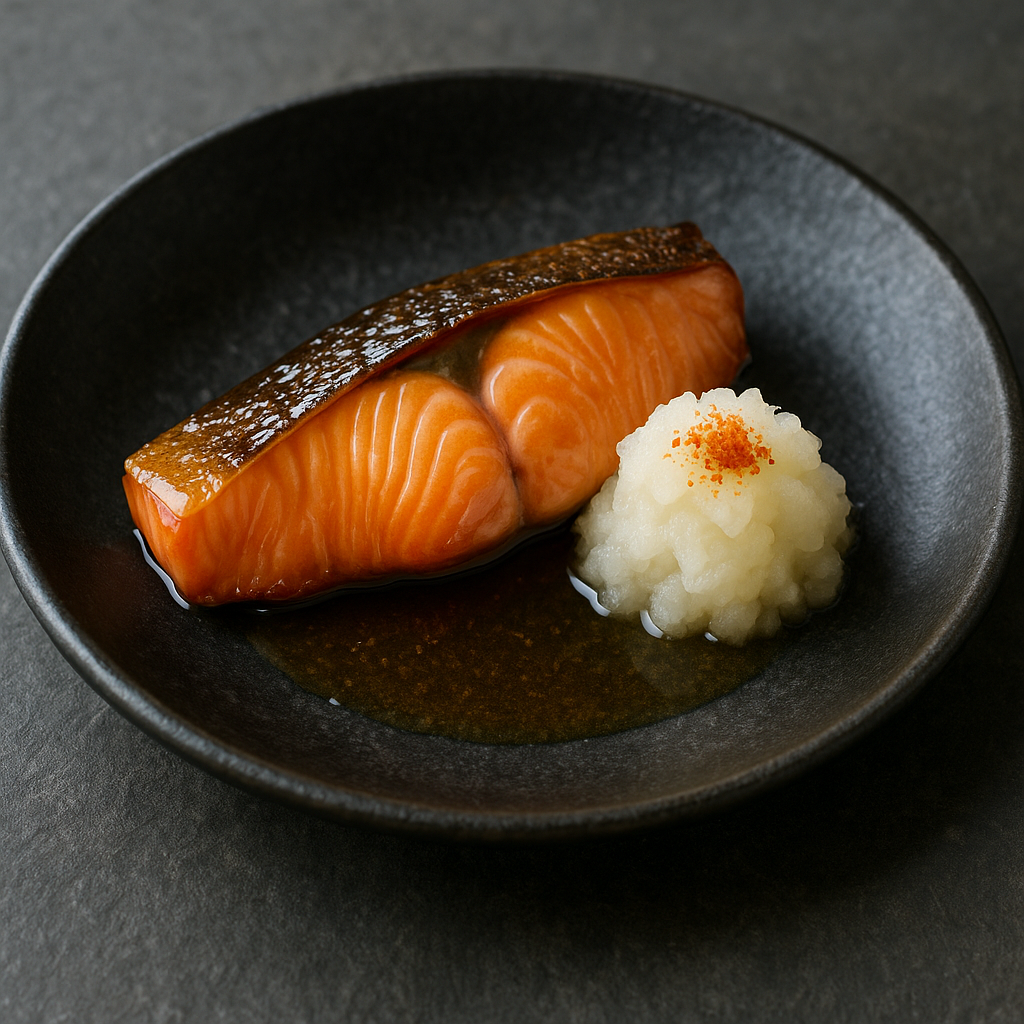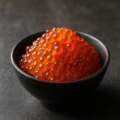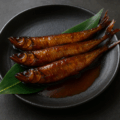トキシラズの焼き漬けの特徴
初夏が旬の上品な脂
トキシラズ(時鮭)は初夏に北海道沿岸で獲れる若い鮭で、過度でない上品な脂が特徴です。焼き上げてからタレに漬けることで、香ばしさと旨味が調和します。
「焼いてから漬ける」技法
表面を香ばしく焼き、余熱が残るうちにだし醤油ベースの漬け地に浸すことで、身の水分が抜けすぎず、しっとりと味が染み込みます。
作り置き・冷やしても美味
冷蔵で数日保存が可能。温かいご飯はもちろん、冷やして酒肴にも合う万能常備菜です。
トキシラズの焼き漬けのレシピ
材料(4人分)
- トキシラズ(切り身) … 4切れ(約400g)
- 塩 … 少々(下味用)
- 油 … 少々(焼き用)
漬け地
- だし … 200ml
- 醤油 … 80ml
- みりん … 60ml
- 酒 … 40ml
- 砂糖 … 小さじ1(好みで)
- 生姜薄切り … 4〜5枚
作り方
- 鍋に漬け地の材料を入れて一度沸かし、アルコールを飛ばしてから粗熱を取る。
- トキシラズに軽く塩を振り、10分おいて出てきた水分を拭く。
- フライパン(または魚焼きグリル)を温め、油を薄く敷いて中火で皮目から香ばしく焼く。返して中まで火を通す。
- 熱いうちに身を漬け地へ入れ、落としラップをして常温で15〜20分、さらに冷蔵庫で1時間以上なじませる。
- 器に盛り、漬け地を少量かけて生姜を添える。
シェフのワンポイントアドバイス
漬け地は「熱すぎず冷たすぎず」がコツ。焼きたての魚を入れたときにタンパクが締まりすぎない、手で触れて温かい程度がベストです。
皮はしっかり焼いて香ばしさを出し、身は火を入れすぎないとふっくら仕上がります。
基本的には1日以上寝かす事でしっとりとした仕上がりになり、味も程よく入ってくれます。
トキシラズの焼き漬けの栄養価(1人分の目安)
- エネルギー:約280〜350 kcal
- たんぱく質:22〜28 g
- 脂質:14〜18 g(鮭由来の不飽和脂肪酸)
- 炭水化物:3〜6 g(漬け地由来)
- ビタミンD・B群(鮭由来)
- EPA・DHA:循環器・脳の健康維持に寄与
高たんぱくで良質な脂質を含み、塩分は漬け地量で調整可能。常備菜としてもバランスの良い一品です。
トキシラズの焼き漬けの歴史
北海道の季節食から家庭の常備菜へ
初夏に出回るトキシラズを無駄なく美味しく食べる知恵として、焼いた鮭をだし醤油に浸す「焼き漬け」は家庭で受け継がれてきました。
保存性と携行性
漬け地に浸すことで日持ちが良くなり、弁当や漁の携行食としても重宝。冷やしても美味しいため夏場の常備菜として定着しました。
現代のアレンジ
生姜や山椒、柚子皮を加える風味付けや、だしを薄めてさっぱり仕立てにするなど、地域・家庭ごとのアレンジが親しまれています。
English Version
Features of Grilled and Marinated Tokishirazu Salmon
Delicate Fat of Early Summer
Tokishirazu (“out-of-season” salmon) is young salmon caught along the Hokkaido coast in early summer. It has a refined, moderate fat content. By grilling the fish and then marinating it, the aroma and umami are harmoniously balanced.
The “Grill Then Marinate” Technique
The fish is grilled until fragrant and then immersed in a soy sauce–based marinade while still warm. This method prevents the flesh from drying out and allows the flavors to gently soak in, keeping it moist and flavorful.
Delicious Made Ahead or Chilled
It can be stored in the refrigerator for several days. Enjoyed with warm rice or chilled as a side dish with sake, it serves as a versatile staple dish.
Recipe
Ingredients (for 4 servings)
- Tokishirazu salmon (fillets) … 4 pieces (about 400 g)
- Salt … a pinch (for seasoning)
- Oil … a little (for grilling)
Marinade
- Dashi … 200 ml
- Soy sauce … 80 ml
- Mirin … 60 ml
- Sake … 40 ml
- Sugar … 1 tsp (optional)
- Ginger slices … 4–5
Instructions
- Combine marinade ingredients in a pot, bring to a boil to remove alcohol, then let cool to warm.
- Lightly salt the salmon, let sit for 10 minutes, then pat dry.
- Heat a pan or grill with a little oil and sear the salmon skin-side down until fragrant. Flip and cook through.
- Place the hot salmon into the marinade, cover with plastic wrap, and let rest at room temperature for 15–20 minutes. Then refrigerate for at least 1 hour.
- Serve with a little marinade poured over and garnish with ginger slices.
Chef’s Tip
The marinade should be warm—not too hot or too cold—so the fish absorbs flavor without the protein tightening. Grill the skin until crisp for aroma, and avoid overcooking the flesh to keep it moist. Resting the fish in the marinade overnight results in deeper flavor and a tender texture.
Nutritional Value (per serving, approx.)
- Calories: 280–350 kcal
- Protein: 22–28 g
- Fat: 14–18 g (healthy unsaturated fats from salmon)
- Carbohydrates: 3–6 g (from marinade)
- Vitamin D and B vitamins (from salmon)
- EPA and DHA: beneficial for heart and brain health
High in protein and rich in good fats, this dish can be adjusted for saltiness by controlling the amount of marinade used. It works well as a make-ahead side dish.
Historical Background
From Seasonal Cuisine to Household Staple
In Hokkaido, grilling and marinating early-summer Tokishirazu salmon was a way to enjoy the seasonal catch without waste. The method has been passed down through generations as a home-style dish.
Preservation and Convenience
Soaking the fish in marinade extended its shelf life, making it practical for bento boxes and as portable food for fishermen. Its flavor also remains delicious when chilled, making it popular as a summer staple.
Modern Adaptations
Today, variations include adding ginger, sansho (Japanese pepper), or yuzu peel for extra aroma, as well as lighter versions with diluted dashi. Each region and household brings its own twist to this Hokkaido specialty.



何でも質問してください!